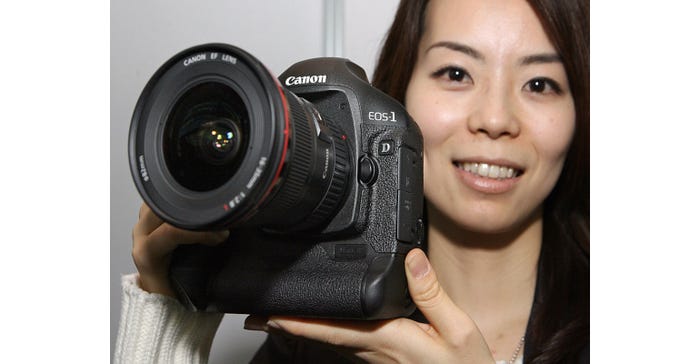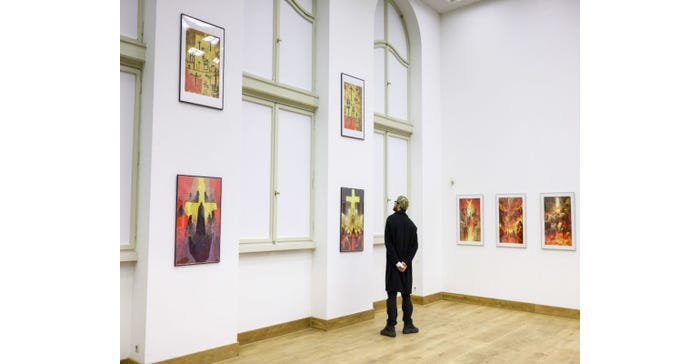From Box Cameras to Smartphones and Beyond: A Look at Photography’s Milestones
Design News traces the long, rich history of photography from its primitive beginnings to its prominent, still-evolving role in today’s high-tech world.

Photography is a huge part of our daily lives. For many of us, our recollections go back to perhaps instamatic cameras and electromechanical single-lens-reflex (SLR) cameras. While some of us still have separate cameras, more likely we are using our camera phones to record and document all types of events.
Over the past week, International Photography Day was celebrated, a day to honor photography. Design News has put together a list of major milestones in the evolution of photography.
Design News would like to thank the sites photographytalk.com, thoughtco.com, and Wikipedia for providing the historical information to help produce this timeline.
Early Optics: 1400s - 1700s
Near the start of the 16th Century, scientist and inventor Leonardo da Vinci sketched out diagrams and wrote instructions about the camera obscura. In these papers, he included not just pinholes but also simple glass lenses.
Early Film: 1604 - 1827
Astronomer Johannes Kepler gets credited with coining the term photograph for a drawing with light in 1604. He was referring to using telescopic optics to project an image onto a sheet of paper or a canvas to draw the stars.
Astronomers and inventors sought a way to make the paper or canvas itself sensitive to light. Glass or metal plates were also used in experiments by various people.
Around 1717, German polymath Johann Heinrich Schulze accidentally discovered that a slurry of chalk and nitric acid into which some silver particles had been dissolved was darkened by sunlight. After experiments with threads that had created lines on the bottled substance after he placed it in direct sunlight for a while, he applied stencils of words to the bottle. The stencils produced copies of the text in dark red, almost violet characters on the surface of the otherwise whitish contents. The impressions persisted until they were erased by shaking the bottle or until overall exposure to light obliterated them.
First Photograph: 1827
It was just one in a series of experiments but View from the Window at Le Gras is the earliest surviving photograph. Nicéphore Niépce used a sheet of metal with a film of chemicals spread on it.
Though light-sensitive, it wasn’t very sensitive. It took 8 hours to record the image. You can see sunlight illuminating both sides of the buildings. From here on, the timeline of photography moves rapidly.
Different metal plate technologies began to be used by astronomers, other scientists, and a new breed of artist/scientists, the naturists. The naturists were quite often scientists and inventors themselves, using this new technology to record the beauty of the world around them.

Daguerreotype: 1839
Around this time, the word photography began to be used to describe this new industry. From 1839 on, the popular metal plate process known as daguerreotype opened up this mix of art and technology to the masses.
Well, the masses that could afford the time and money involved anyways. Though it may have been one of the easier metal plate photographic processes, it was still messy, expensive, very time consuming, and somewhat dangerous.
Earliest Camera: 1841
Photographers of this era generally used cameras designed and made by themselves or skilled craftsmen, adapting lenses made by optical manufacturers to use photographically.
Early in the camera timeline of the history of photography, optical companies such as Zeiss, Leitz, and others started to design lenses specifically for photography. Voightlander went a step beyond and introduced a camera for metal plates in 1841.
Developing Film Cameras
The problem with metal and glass plates was that they were fragile, cumbersome and hard to work with, and costly for the average person.
A combination of two technologies, silver halides and celluloid based emulsions would undergo further development. In 1835, Henry Fox Talbot invented a viable method of spreading a gelatine emulsion on paper. In 1839, astronomer John Herschel came up with a way to fix the image recorded by silver halides.
Late in the 1800’s, George Eastman pioneered the use of photographic film. Eastman started manufacturing paper film in 1885 before switching to celluloid in 1888–1889. His first camera, which he called the "Kodak", was first offered for sale in 1888. It was a very simple box camera with a fixed-focus lens and single shutter speed, which along with its relatively low price appealed to the average consumer.
The Kodak came pre-loaded with enough film for 100 exposures and needed to be sent back to the factory for processing and reloading when the roll was finished. By the end of the 19th century Eastman had expanded his lineup to several models including both box and folding cameras.
35-mm Film
Another major photographic milestone was the development of 35-mm film. Oskar Barnack, who headed research and development at Leitz, decided to investigate using 35 mm cine film for still cameras while attempting to build a compact camera capable of making high-quality enlargements. He built his prototype 35 mm camera (Ur-Leica) around 1913, which transported the film horizontally, producing a 24x36mm image frame.
After World War I, Leica commercialized their first 35 mm cameras.
Single-lens-reflex Cameras
It was the single-lens-reflex (SLR) camera that paved the way for contemporary photography, first electromechanical and later digital versions. The first practical reflex camera was the Franke & Heidecke Rolleiflex medium format TLR of 1928. Though both single- and twin-lens reflex cameras had been available for decades, they were too bulky to achieve much popularity. The Rolleiflex, however, was sufficiently compact.

1933 saw the introduction of the Ihagee Exakta, a compact SLR which used 127 rollfilm. This was followed three years later by the first Western SLR to use 135 film (otherwise known as 35 mm film), the Kine Exakta. The 35 mm SLR design gained immediate popularity and there was an explosion of new models and innovative features after World War II.
The first major post-war SLR innovation was the eye-level viewfinder, which first appeared on the Hungarian Duflex in 1947 and was refined in 1948 with the Contax S, the first camera to use a pentaprism. Prior to this, all SLRs were equipped with waist-level focusing screens. The Duflex was also the first SLR with an instant-return mirror, which prevented the viewfinder from being blacked out after each exposure. This same time period also saw the introduction of the Hasselblad 1600F, which set the standard for medium format SLRs for decades.
In 1952 the Asahi Optical Company (which produced Pentax cameras) introduced the first Japanese SLR using 135 film, the Asahiflex. Several other Japanese camera makers also entered the SLR market in the 1950s, including Canon, Yashica, and Nikon. Nikon's entry, the Nikon F, had a full line of interchangeable components and accessories and is generally regarded as the first Japanese system camera.
35mm SLRs became one of the primary types of cameras for photographic images. Their form factor and image format are still one of the more dominant forces in modern digital photography.
Digital Cameras
The roots of digital photography, which would revolutionize the industry, began with the development of the first charged-coupled device at Bell Labs in 1969. The CCD converts light to an electronic signal and remains the heart of digital devices today. In 1975, engineers at Kodak developed the very first camera creating a digital image. It used a cassette recorder to store data and took more than 20 seconds to capture a photo.
By the mid-1980s, several companies were at work on digital cameras. One of the first to show a viable prototype was Canon, which demonstrated a digital camera in 1984, although it was never manufactured and sold commercially. The first digital camera sold in the U.S., the Dycam Model 1, appeared in 1990 and sold for $600. The first digital SLR, a Nikon F3 body attached to a separate storage unit made by Kodak, appeared the following year. By 2004, digital cameras were outselling film cameras.
By 2004, the sensor in the Canon EOS 1D Mark II had surpassed the resolution of the former industry standard Kodachrome slide film. Digital SLRs were pretty much taking over from 35mm SLRs.

Smartphones Take Over
Today, most mobile devices—particularly smartphones—have cameras built into them. Samsung introduced the first smartphone camera—the SCH-V200—in 2000. but it was not until the introduction of the Apple iPhone in 2007 that the smartphone started to become a key medium for digital photography. Since then, improved sensors and optics have enabled smartphones to incorporate digital cameras that are rivaling discrete digital cameras for performance.
By 2013, smartphones with camera capabilities were outselling digital cameras more than 10-to-1.1 In 2019, more than 1.5 billion smartphones (most of which have camera capabilities) were sold to consumers, compared with about 550,000 digital cameras over roughly the same period.
Will AI Shake Up Photography?
The rise of artificial intelligence (AI), particularly generative AI, has led to concerns that the future of photography may lie in some algorithms rather than the creativity of photographers. AI software can now be trained to produce images of objects and people that, while far from perfect, are in some cases reasonable facsimiles. This is an area to keep an eye on, as ongoing developments in generative AI software are likely to produce results that are more accurate and realistic.
The obvious question is, will photographers that were weaned on traditional photographic technology and adopted digital imaging technology now join another potential wave of photographic technology upheaval? Only time will tell.

About the Author(s)
You May Also Like





